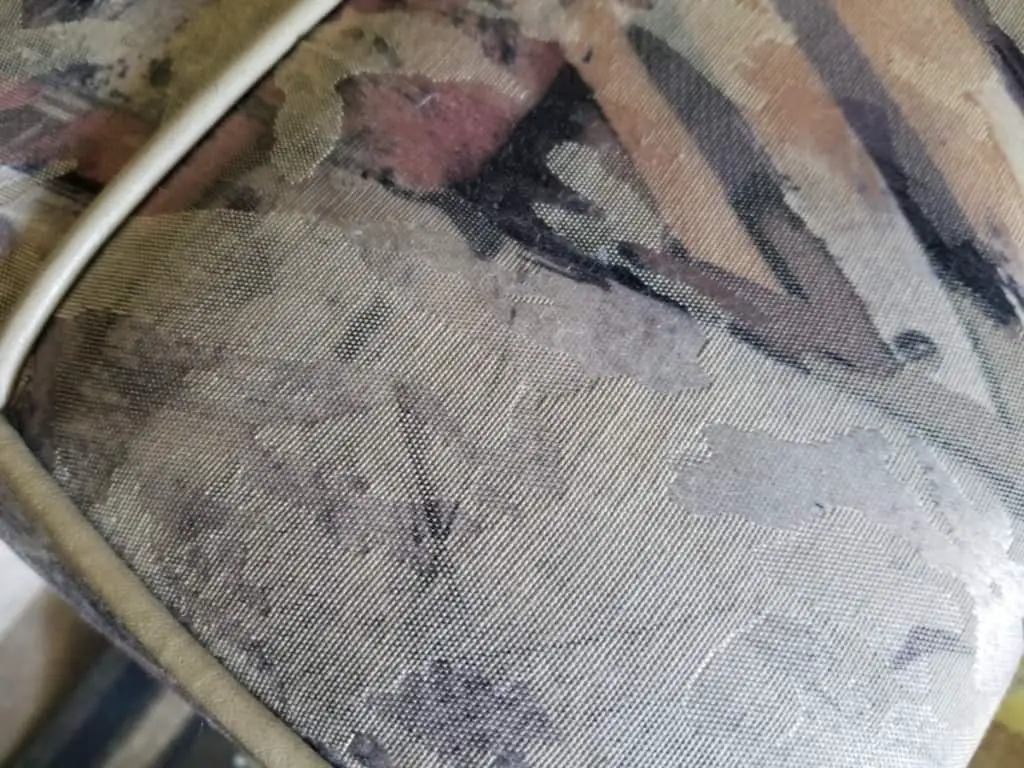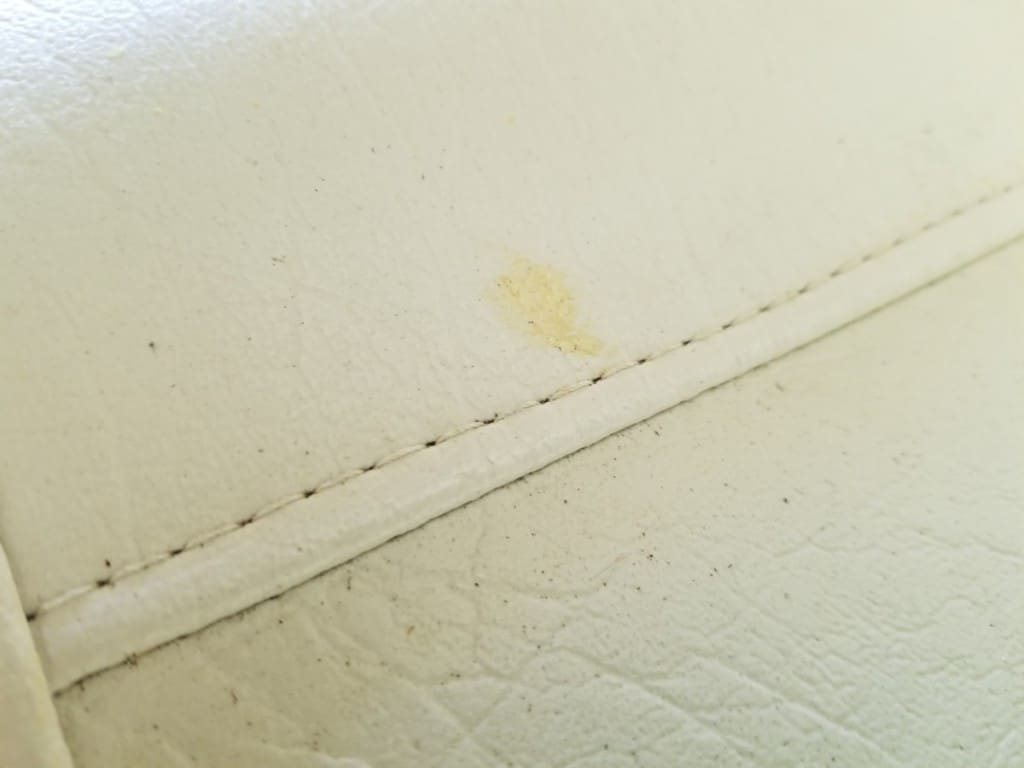If you buy your boat used, or if you’ve just been taking it out on the water a lot, you might notice a bit of a smell or discoloration to your cushions inside the cabin.
I was curious when we started looking for the perfect Cuddy Cabin for our family what the best way would be to clean the interior cushions for proper
After a few hours of research, I found a few generally agreed upon methods from experienced boaters, and I’ll share the best of what I’ve learned to save you some time.
If you’re more interested in cleaning vinyl boat seats instead of fabric-based boat cushions, you can check out my article here with tips, things to avoid, and recommended products.
How to clean boat cushions:
It may depend on the material that your cushion covers are made of, but some popular methods include:
- Upholstery professional
- Steam clean
- Front-end only machine wash the covers on cold, air dry only
- Pressure Washer
- Borax and
Vinegar solution for killing mold in the foam cushions
That’s the quick and easy answer from the research that I’ve done on how to best get them clean from experienced Cuddy Cabin and Cruiser owners. If you continue reading, I’ll break down these methods a little more in-depth, and share 9 tips and tricks I’ve learned to keep your boat’s cushions fresh, clean, and hassle free!

Take them to an Upholstery Professional
This is probably the easiest method to clean the cushions and removes nearly all of the hassle for yourself and leaving it for someone with experience. Plus, you don’t have to worry about screwing something up and shrinking the covers!
The downside is that you’ll have to shell out a little money to do it. From what I read, you could probably find a professional to do it for about $100 to $200. If you’re short on time and don’t want the headache, this method is probably a great choice for you.
Steam Cleaning your Boat’s Cushions
Lots of boat owners tout the benefits of simply steam cleaning their cushions. This is likely more for basic maintenance of their freshness and in no way substitutes for a deep clean if the problem with your cushions is below the covers, but if you do it often enough from the start it might keep you satisfied.
It is recommended to test out the reverse side of a cushion before steaming everything to make sure your fabric doesn’t have any adverse reaction to it (discoloration, deterioration, shrinking) and to keep the covers on the cushions when doing the procedure in case there is a shrinkage of the material.
If all goes well, steam is a great way to keep things smelling fresh and to kill bacteria on or near the surface and can be an excellent and ideal choice for cleaning the cushions up top as well! Properly applied steam with a wipe down can bring the original colors of your cockpit cushions back to life by removing stubborn mold and mildew.
Front-end Wash on Cold
It’s pretty universal from my research that front-end washers are preferred over top loading washers for cleaning cushion covers. The agitating spindle in the middle of the top loading washers is notorious for snagging things that it shouldn’t and causing rips and stretches where it shouldn’t.
Remember that sustained heat is your enemy with washing fabrics because it can cause major shrinkage or discoloration. It is best to wash on cold for the entire wash and to use the delicate cycle. Some Cuddy Cabin owners claim to use warm for wash and cold for rinse, but I’d rather play it safe than sorry.
Overall, the choice of detergents did not appear to be an issue with anyone, so I would stick with something mild and use what you would normally use or a little less. I did read one or two complaints about Oxiclean making the colors bleed on interior cuddy cushions, but I cannot confirm that this alone was indeed the reason.
To avoid this, you could use the detergent of your choice and mix a small amount in some cold water and do a spot application on the reverse side of the cushion, followed by a gentle rinse and air dry. Check for any bleeding of the colors, and proceed how you see fit.
Pressure Washing your Boat’s Cushions
While this method seems great for cleaning the cushions on the top deck, it can make some cringe when thinking about doing it to the delicate cushions down below. I came across a lot of people in my research that swear by this method and insist that there are 4 primary things that must be present:
- The cushions must be in good order. Torn covers or those that are wearing thin should not be pressure washed.
- Thoroughly air dry in the sun for 24-48 hours. The pressure washing is done with the cushions inside, and all of that moisture needs to dry or you risk mold and mildew!
- Make sure to use a nozzle that has a wide angle to it that is designed for washing, and not stripping paint.
- Keep the washing nozzle a safe distance away from the fabric. There is a sweet spot when using a pressure washer and having the nozzle too close to anything can devastate it, but having it too far away makes it function just like a garden hose.
The method basically involves using a gentle brush to lather on (and scrub any stains) the cold water mixed with detergent, and then pressure washing the entire cushion with the cover until the soap stops foaming out of it.
Make sure to keep the drying cushions away from pet hair if you have to bring them inside the garage!

Washing the Foam Inserts with Borax and Vinegar
This was perhaps my most favorite method that I came across for cleaning the foam inserts of your cuddy cabin! It is super cheap and it’s a method that is applicable to anything that has a foam insert too!
For this
- If you suspect mold or mildew in your cushions, remove them from the covers and clean the covers separately with one of the methods mentioned above.
- Mix a solution of warm water, vinegar, and borax into a bucket, kiddie pool, or bathtub. (1 cup borax and 1 cup white vinegar per gallon of warm/hot water)
- Stir or mix the water until the borax crystals dissolve.
- Place your cushions one at a time (or as many as can fit) into the solution and let them soak up as much of the liquid as they can. Place them on a clean tarp and let them sit in that state for 5 to 10 minutes.
- Very gently press out as much excess liquid as you can back into the bucket/tub, and place a foam insert into a trash bag/drum liner.
- Prepare the vacuum for sucking up liquids. Place the end of the vacuum hose into the bag just above the foam insert and close the bag by hand around the hose.
- Turn on the vacuum and it will pull out the air and begin to pull the borax solution through all of the pores of the foam as it works its way to the hose. This borax+vinegar solution will kill and prevent any mold and bacterial growth. You can
prick the other end of the bag a time or two to allow a small flow of air as well to the vacuum. - Remove the insert, and place it in a place to thoroughly air dry. Any mold should now be dead and they should prevent future mold growth with the foam being impregnated by the borax solution!
- Repeat steps 5-9 until all of the cushions have been treated.
Helpful Cushion Cleaning Tips from the Experts:
- Try keeping Norwex Envirocloths onboard your vessel and use these to both remove stains and to do periodic wipe downs of all of the surfaces on your boat. These microfiber cloths are washable and reusable, and are excellent at removing stains. They only require being dampened with a little water and you’re good to go. We keep them on our boats, in our cars, and in the house.
- If you need new cushions, make sure to avoid cushion covers that are cotton or a cotton blend. Natural materials will not hold up well to the moist conditions experienced out on the lake and are more prone to
rot, deterioration and mildew build-up. Stick with acrylic, polyester, or olefin. - When placing a cover back on a foam insert, it is easiest to do it when the cover is still just a bit damp and not completely dry. This allows for maximum stretching before the material dries.
- An even easier way to get those dreaded inserts back into the covers is to place a plastic bag/trash bag over the inserts with the open end going in first. Fold the open end a few times on itself to keep it closed and push the insert into the cover. The plastic will reduce nearly all of the friction and it will slide in like a hot knife through butter! To retrieve the bag, just pull gently on the end that you’re holding onto and it should pull right out!
- 303 Marine Fabric Guard or Scotch Guard are great ways to protect your cushion covers against moisture and stains in between cleanings. I have a link here to both on Amazon if you’d like to check out the prices. 303 Marine Fabric Guard or Scotch Guard Fabric and Upholstery Protector.
- Try to make it a habit to clean your cushions at least once a year, preferably at the end of your boating season so the mildew and bacteria don’t sit in and on the cushions throughout the entire offseason.
- You can always rent (if you don’t own one) a carpet cleaning machine with an upholstery attachment and use that to clean your cushions as well.
- If you have metal zippers on your cushion covers and they are hard to zip, use a toothbrush and a little vinegar to remove the corrosion that has built up. You can treat the zippers with an Amazon product like this or simply use some paraffin wax or chapstick. If you want to avoid this problem altogether you can always get covers that have plastic zippers!
- Never put items in the dryer!
- After an outing, place a running fan in the cuddy with the hatch or hatches open to thoroughly air it out and dry it in between trips.
- Finally, before you do any method of cleaning, SPOT TEST! SPOT TEST! SPOT TEST! on an inconspicuous area first!
